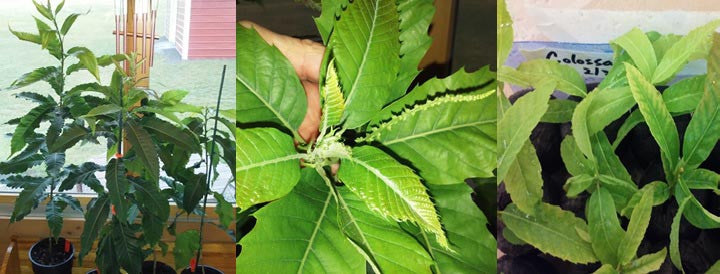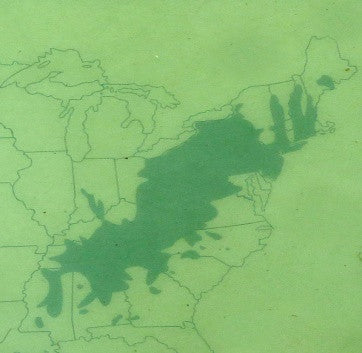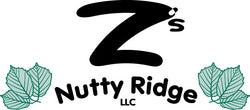About Chestnuts - The Native Rock Stars

Chestnuts are our Native Rock Stars.
Chestnuts have been grown throughout Europe, China, Japan and United States as a food staple since time immemorial. The Native American chestnut trees are susceptible to the chestnut blight and are all but eradicated. The foreign Chinese chestnut trees brought a blight (Cryphonectria parasitica) to North America that the Chinese trees are resistant to. The native trees are now being crossed and back crossed to develop blight resistance by The American Chestnut Foundation (TACF) and other researchers.
Chestnut trees and their close relatives come in all sizes from bush to “Redwood” timber size. The American chestnut tree is a very large timber type tree with relatively small chestnuts. The European, Japanese and Chinese chestnut trees have a long history of being cultivated for nuts and the named selections are generally a size similar to a standard apple tree with large nuts that can be 10 nuts to the pound. The chestnut industry is growing as the crop is sustainable, soil friendly and well accepted by the consumer. According to a recent newspaper report, a 17 acre chestnut orchard and winery in upstate NY sold out of chestnuts in one day during their chestnut festival selling chestnuts at $3.50 per pound. Chestnuts typically sell for $7.00/lb.in stores.
A mature well planned and maintained hybrid chestnut orchard with a proper mix pollinizers and pollen sterile trees should achieve well over 2000 to 3000 pounds of nuts per acre. In a banner year 7000lbs have been reported in Michigan. The trees will grow wherever in North America there is enough warmth, well drained soil and rain, as the native area is expansive as shown in Figure #1. Chestnuts are now grown from Michigan to Florida.

Commercial chestnut orchards are currently suggested to have either European and/or Japanese hybrids in an orchard or have Chinese hybrids in an orchard; but, do not have both types of trees in the same orchard. A phenomenon known as Internal Kernel Breakdown (IKB) has been described by Dr. Fulbright of Michigan State University Extension. The main cultivar grown in Michigan is Colossal and it was found when nuts from Colossal were pollenated by a Chinese chestnut tree that up to 30% of the nuts would quickly rot internally making the crop suspect at best. Also in Michigan growers have found the European and Japanese hybrids produce 2 to 5 times the nuts that Chinese chestnuts do and produce nuts at a much earlier age.
Like any fruit, grain or nut crop there are pests and diseases that like it as much as we do. The main issues are: chestnut blight, chestnut weevil and root rot. Another potential pest not seen here in our farm is the Asian chestnut gall wasp. Chestnut trees like any tree are also subject to the normal leaf eating pests and normally they can be controlled if necessary with traps.
Growing chestnuts is easy once you know how and we explain it in our book, "The Hazelnut and Chestnut Handbook".
Root Rot
It is important to plant chestnut trees in well drained soil as chestnut trees are susceptible to root rot where the soil remains wet for extended periods of time. A farmer always knows where the wet spots are in the field as they are in the low lying areas and swails where water drains first before draining further downhill. Japanese chestnut strains are most resistant to root rot and some hybrids are as well. It is best to avoid wet areas and keep in mind that the odd wet year may cause your 10 year old chestnut tree to die from root rot.
Chestnut Weevil
The best method to control chestnut weevil is with preventative measures. As the nuts drop they must be picked up off the ground within two or three days. The weevil larva emerges from the nut a few days after they are on the ground. If the nuts have been gathered you break the life cycle of the weevil. Nuts that are gathered need to be subject to a 120F +/-2F water bath for 20 minutes to kill the larvae and allow the nut to still be viable. Nuts that had larvae in them will have a small pin hole the size of pencil lead. You will know if you have them as the larvae are little white grub/maggots.
If you see much more than 5% of the nuts have weevils then you will need to most likely spray insecticide to control them. An excellent paper is located at: http://www.centerforagroforestry.org/weevil.pdf.
Orchard Planning and Management
Spacing is dependent on the tree cultivars selected. Current recommendations are to double plant the trees and cull every other one when they become overcrowded. For European and Japanese hybrids the final spacing of 30’ X 30’ (48 trees per acre)should be good and anything less than 20’ X 30’ will be too tight. For an excellent practical overview please see: Orchard Design & Establishment - Chestnuts (msu.edu)
The soil pH must be proper for the tree to grow and thrive. Soil pH should be 5.5 to 6.5, much lower or much higher the trees won’t do well. If the tree is chlorotic(yellow) it is a good sign that the soil is near neutral (7.0pH) and the pH needs to be adjusted if possible or do not plant in the area.
Fertilization will depend on the age of the tree and size of the tree. Leaf analysis is used to verify the condition and needs for macro (N,P, & K) and micro nutrients. Fertilizer recommendations usually include ammonium sulfate to acidify the soil around the tree. Again a very practical paper is at the MSU Extension at: Nutrient Management - Chestnuts (msu.edu)
Irrigation is usually needed for transplanted trees for either bare root or potted trees for continued growth and survival. Bare root trees are freshly dug up and a majority of the roots have been cut off during the digging. If the tree is a potted tree, the root system has been constrained. Potted plants are usually watered to near ideal conditions, allowing the tree top to grow much more than the roots would normally allow. Although the potted tree may be in better shape when planted out, the tree will also need to be watered. The newly planted trees must be watered by hand, or irrigated. We have done both depending on the location and the amount of trees planted. If planting out an orchard nearing an acre in size we strongly suggest looking into drip tape.
We describe the practices for an orchard and the above will apply for the homeowner or hobbyist and any agricultural system. Different systems include: silvopasture, permaculture, agroforestry and woody agriculture. These systems utilize trees as an integral part of a sustainable agricultural practice. We believe this trend will continue to grow and lead both environmentally and economically over annual grain crops.
"You know planting trees are good for the environment; but, nut trees are good for you too"
I would like to plant out some chestnuts, but what do I plant seedlings or grafted cultivars? This is a common question and it appears that the answer is seedlings double planted and cut out half of the least productive trees to allow the trees to not crowed each other. Remember chestnuts have been hybridized for thousands of years and buying seedlings of trees that are hardy for our region has found to be what works best. This conclusion is the result of a few reports and current growers from Cornell and Route 9 Cooperative. Grafted cultivars are notorious for failing at the graft union over the years and not being as productive as seedlings. The seedling however needs to be the result of known parents that thrive and produce well in our region.
In our opinion the trees in the Missouri Horticulture and Agroforestry Research Center(HARC), trees from Greg Miller in conjunction with the Rt 9 Cooperative and regionally proven trees from Z's Nutty Ridge and other regional nurseries are good candidates for you to plant. Below is a regionally adapted chestnut tree we call ZCC. Some years the branches bend from the weight of all the chestnuts.

